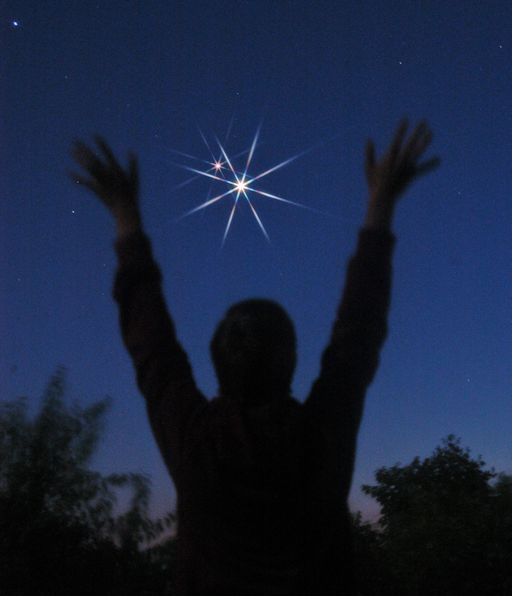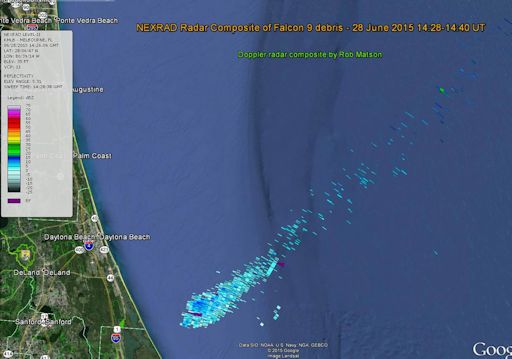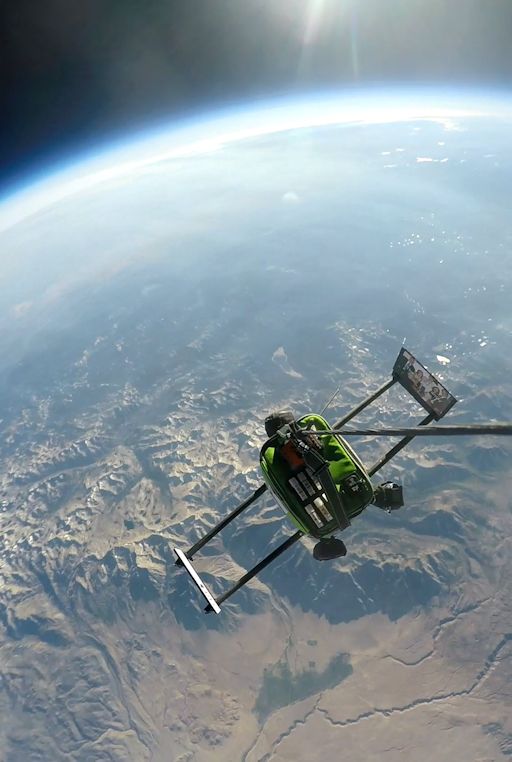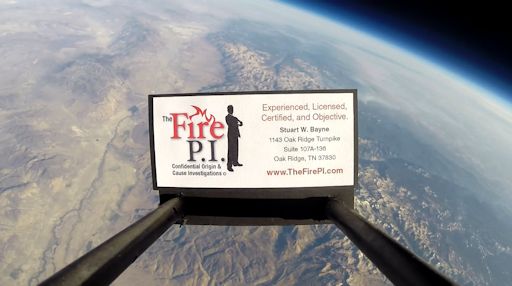Come to Tromsø and share Marianne's passion for rural photography: Chasethelighttours.co.uk invites you to experience "Heaven on Earth" with an aurora, fjord, fishing, whale watching, photography or sightseeing tour. | | |
QUIET SUN: Solar activity has returned to low levels. Indeed, with no sunspots actively flaring, the sun's X-ray output is flatlining. NOAA forecasters estimate a 10% chance of M-class solar flares and a scant 1% chance of X-flares on June 30th. Solar flare alerts: text or voice.
SUNSET SKY SHOW: Warning. Stepping outside at sunset could cause you to throw up your hands and shout, Look at that! McKenzie Watson experienced the phenomenon just last night in Jonesborough, Tennessee:

"McKenzie couldn't help but celebrate the conjunction of Venus and Jupiter,"explains photographer Mark Marquette. "It was breathtaking."
Anyone can have a similar experience in the nights ahead. Just step outside after sunset and face west. Venus and Jupiter are less than a degree apart. Don't wait until the sky fades to black. A tight conjunction of Venus and Jupiter framed by twilight blue has a special beauty that you won't want to miss.
The night of closest approach is June 30th, when Venus and Jupiter will be only 1/3rd of a degree apart. If you have binoculars or a small telescope, point them at the planets. Both will fit in the same field of view, allowing you to see the fat crescent phase of Venus and the moons of Jupiter simultaneously. It's a great way to end the day.
Realtime Space Weather Photo Gallery
DRAGON DEBRIS: On Sunday morning, a SpaceX Falcon 9 rocket lifted off from Cape Canaveral bound for the International Space Station. Two minutes and 19 seconds later, it exploded. The Dragon spacecraft on top of the rocket was carrying more than 4,000 pounds of food and supplies--suddenly turned to ash. A weather radar in Melbourne FL tracked the airborne debris:

"Figuring that the debris cloud would likely show up on Doppler, I pulled the NEXRAD data for the Melbourne radar," says Rob Matson, who created the graphic. "High altitude (21.5-km) debris first appears a little after 14:28 UT (10:28 am EDT), which was a little less than 5 minutes after the failure. This image is a composite of 29 sweeps over a period of about 12 minutes."
"I figure debris will starting washing ashore near Daytona in the next day or two," he adds.
Matson has also supplied a kmz file for the radar data. Using that file, you can explore the debris plume in Google Earth. "You can get an idea of the early cloud
evolution by clicking on the right tab of the slider bar at upper left and sliding
your mouse left and right," he advises.
SPACE WEATHER MUTATES MICROBES: Regular readers know that Spaceweather.com and the students of Earth to Sky Calculus have been launching microbes to the edge of space, more than half a dozen times since April. Carried aloft by helium balloons, halobacteria are now frequent fliers to the stratosphere. An early finding of this ongoing experiment is that the microbes are mutated during their trip, probably by exposure to galactic cosmic rays. Would they be mutated even more by a solar storm? That's what the students wanted to find out, so on June 22nd they launched a new batch of microbes during the strongest solar storm of 2015. Here is the payload 108,213 feet above Earth's surface:

At the time of the flight, a severe G4-class geomagnetic storm was underway. After nightfall, people would see auroras as far south as California and Arizona. In addition, a maelstrom of solar protons were bombarding Earth's magnetic field, producing a moderately-strong S2-class radiation storm.
Will any of this affect the mutation rate of the microbes? Microbiologists Shil and Priya DasSarma are culturing the halobacteria now in their NASA-funded laboratory at the University of Maryland. When their results are available and confirmed, we will share them.
Astrobiologists have a special interest in halobacteria. This extremophile has the ability to shield itself from harmful radiation and to repair damaged DNA. Researchers have speculated that it might be able to survive on the planet Mars. The temperature, air pressure, and radiation environment in Earth's stratosphere is similar to Mars, so a balloon flight is a good way to test halobacteria's "Red Planet readiness."
HEY, THANKS! All of the high-altitude astrobiology research featured on Spaceweather.com is crowd-funded. This particular flight was sponsored by Stuart Bayne, a.k.a. The Fire P.I., an expert investigator of fires and explosions. Here is his logo at the apex of the flight:

His generous donation of $500 paid for the helium, the balloon, and other supplies required to get this mission off the ground. In return, he will receive a full-length HD video of the flight. Thanks, Stuart!
Readers, would you like to sponsor a research flight and see your favorite photo or business logo at the edge of space? If so, please contact Dr. Tony Phillips to make arrangements.
Realtime Aurora Photo Gallery
Realtime NLC Photo Gallery
Realtime Sprite Photo Gallery
Every night, a network of NASA all-sky cameras scans the skies above the United States for meteoritic fireballs. Automated software maintained by NASA's Meteoroid Environment Office calculates their orbits, velocity, penetration depth in Earth's atmosphere and many other characteristics. Daily results are presented here on Spaceweather.com.
On Jun. 30, 2015, the network reported 88 fireballs.
(86 sporadics, 1 Microscorpiid, 1)

In this diagram of the inner solar system, all of the fireball orbits intersect at a single point--Earth. The orbits are color-coded by velocity, from slow (red) to fast (blue). [Larger image] [movies]
Potentially Hazardous Asteroids (
PHAs) are space rocks larger than approximately 100m that can come closer to Earth than 0.05 AU. None of the known PHAs is on a collision course with our planet, although astronomers are finding
new ones all the time.
On June 30, 2015 there were potentially hazardous asteroids.
Notes: LD means "Lunar Distance." 1 LD = 384,401 km, the distance between Earth and the Moon. 1 LD also equals 0.00256 AU. MAG is the visual magnitude of the asteroid on the date of closest approach. | | The official U.S. government space weather bureau |
| | The first place to look for information about sundogs, pillars, rainbows and related phenomena. |
| | Researchers call it a "Hubble for the sun." SDO is the most advanced solar observatory ever. |
| | 3D views of the sun from NASA's Solar and Terrestrial Relations Observatory |
| | Realtime and archival images of the Sun from SOHO. |
| | from the NOAA Space Environment Center |
| | the underlying science of space weather |
| | Web-based high school science course with free enrollment |

